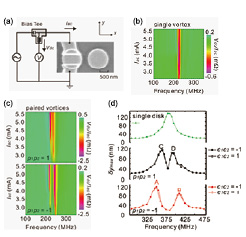Dynamics of Coupled Vortices in a Pair of Ferromagnetic Disks
Otani Group
Magnetic vortex is one of the fundamental spin structures in submicron-sized ferromagnetic elements. It is characterized by two degrees of freedom, i.e., the in-plane curling magnetization “chirality (c = ±1)” and the out-of-plane magnetization “polarity (p = ±1)”. In the low frequency excitation state, called the “gyration mode”, the vortex core with perpendicular magnetization rotates around its equilibrium position. This is analogous to a motion of point mass in a harmonic potential. When magnetic vortices are arranged at a distance of submicron, they are coupled through dipolar interaction induced by the surface magnetic charges on the edges. Especially a pair of magnetic vortices can be regarded as an “artificial” molecule bound via the dipolar interaction. As in the case of a diatomic molecule with the van der Waals bonding, the energy levels of the artificial molecule (bonding and anti-bonding states) should depend on the combination of chiralities and polarities. Furthermore, by arranging the magnetic vortices in a two-dimensional array, one could expect the so-called “magnonic crystal” [1]. In spite of such a high potentiality for application, there are few experimental reports on the coupled vortices via direct exchange interaction and also dipolar interaction in physically separated vortices. In this work, we demonstrate the experimental evidence of the resonant excitation of a magnetostatically coupled pair of vortices as a clear mode splitting of spectra.

Fig. 1. (a) Schematic diagram of our measurement setup for the spin torque diode effect and a scanning electron microscopy image of the sample. (b), (c) Frequency and power dependencies of the normalized dc voltage Vdc/Iac measured for an isolated disk (b) and for the paired disks with different polarities (c). (d) Simulated core displacement for a single vortex as well as for a pair of vortices. As mentioned in the main text, such a core displacement results in a dc voltage via the spin torque diode effect
Figure 1 (a) shows our experimental setup. To detect the gyration mode, we adopted the spin torque diode effect via the anisotropic magnetoresistance of permalloy (Py) disks. When an ac current is injected into a Py disk, the vortex core gyrates only at the resonant frequency. In this process, the magnetoresistance of the Py disk also oscillates with the same frequency. As a result, a dc voltage is generated only at the resonant frequency. As shown in Fig. 1(b), a clear resonant mode is detected at 220 MHz. This resonant frequency is reproduced by our micromagnetic simulation (see the top panel of Fig. 1(d)).
When two Py disks are arranged in a pair with a separation distance of ~100 nm (see Fig. 1(a)), a coupled vortex core motion should be reflected on the dc voltage. As can be seen in Figs. 1(b) and 1(c), a single resonance line observed for the single disk splits into two resonance lines and there appear in total four different modes depending on the product of two polarities p1p2 [2]. Compared with our micromagnetic simulations, the observed four different modes can be identified with the polarities p1p2, chiralities c1c2 of the two vortex cores (see Fig. 1(d)). The unique property in this system gives us a guiding principle for designing the magnonic crystal in further expanded systems such as one-dimensional chains and two-dimensional arrays and is a candidate for novel tunable oscillators using vortices.
References
- [1] J. Shibata and Y. Otani, Phys. Rev. B 70, 012404 (2004).
- [2] S. Sugimoto, Y. Fukuma, S. Kasai, T. Kimura, A. Barman, and Y. Otani, Phys. Rev. Lett. 106, 197203 (2011).
